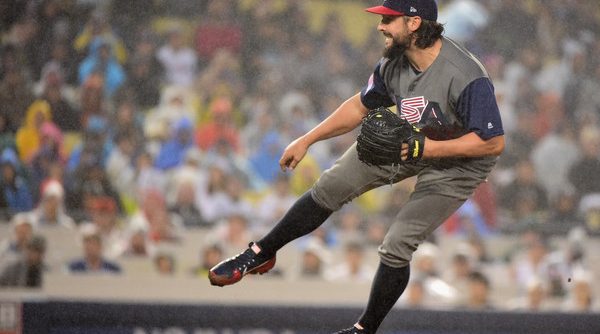Coming off of a disappointing 2015 spent shuttling between the bullpen and the starting rotation, it felt like Tanner Roark was the forgotten man in the Nationals’ 2016 rotation. All Roark went on to do was post the sixth-lowest ERA in baseball among qualified starting pitchers. Not bad for a guy who throws in the low 90s and was never a top prospect.
The obvious question to ask as Roark takes the mound for the first time in 2017 is: Can he run back his 2.83 ERA from 2016 again this season? There are plenty of reasons to doubt that Roark is the real deal. For one, his stuff isn’t elite. He throws a low 90s fastball, which isn’t as impressive in today’s big leagues as it used to be. He has a smattering of off speed pitches, but none of them stand out from the pack. On top of that, take a look at this comparison:

Player A is Roark. Solid stats, sure, but nothing earth shattering. Player B? None other than Gio Gonzalez, the same Gio Gonzalez who was seen as expendable this off season as the Nationals chased a proven closer. Somehow, Roark and his 2.83 ERA matches up almost identically in all the major pitching peripheral stats to the Nationals fifth starter. To some people, that screams out for regression to hit Roark hard in 2017.
As the baseball world continues to research the art of pitching, it is becoming clearer that there is more to pitching than just walks and strikeouts and there is no better example of that than Tanner Roark. He doesn’t have great stuff compared to elite prospects, but he knows how to make his pitches work off of one another. He throws his sinker at only 92 MPH over 60% of the time, but he gets so much movement on it that hitters can’t square the pitch up consistently, even when they know it’s coming. His off speed pitches all work off of each other and the sinker effectively and though they are not impressive pitches on their own, they are all above-average pitches based on their results.
Roark is also learning how to better use his pitches. His velocity was actually down in 2016 compared to 2015, but by cutting back on the velocity Roark got more movement on his pitches. That resulted in the highest strikeout rate of his career. Where Roark really shines is his ability to induce weak contact. In 2016, Roark induced soft contact on 23% of the balls put into play off of him. Compare that to a hard hit rate of only 24%. The only pitcher with a better ratio of soft hit balls to hard hit balls? Cy Young contender Kyle Hendricks. In fact, the comparisons between the two soft tossing, fastball-reliant pitchers doesn’t end there. Hendricks gave up a batted ball velocity significantly lower than the league average. Batters hit the ball only 87.2 MPH off of the Cubs righty. Sitting just above Hendricks in the velocity chart is Tanner Roark, with a batted ball velocity allowed of 87.8 MPH. That ability to induce weak contact is the Secret Stuff to being a successful big league pitcher without an elite arsenal of pitches.
The biggest downside to this style of pitching, though, is the inherent reliance on the defenders behind the pitcher. A pitcher like Max Scherzer, with a strikeout rate north of 30%, can be successful in front of almost any defense because he gives up so few batted balls. Tanner Roark’s goal, though, is to get hitters to put balls in play. That formula worked for him last year, in front of last year’s Nationals defense. While the Nationals return a good chunk of that defense in 2017, there are a couple major changes. With Adam Eaton now roaming center field and Trea Turner at shortstop, there is a chance that the defense takes a step back. If early returns (i.e. one game) are any indication, it won’t be a problem. But if Roark does struggle in 2017, his BABIP allowed will probably be the culprit.
Assuming the defense holds up, Roark should be set up for another stellar campaign in 2017. Though the smart money is on Roark’s ERA to creep up in 2017, that’s only because it’s so hard for anyone not named Clayton Kershaw to put up sub-3 ERAs on the regular. Though people outside of DC may not yet fully appreciate it, Roark is the third part of the Nationals great pitching triumvirate, a 1-3 pitching staff that rivals any in the country. If he keeps pitching like he did in 2016, though, he won’t be so anonymous for long.
Tags: 2017 player previews, Nationals, Nats, Tanner Roark, Washington Nationals




Leave a Reply